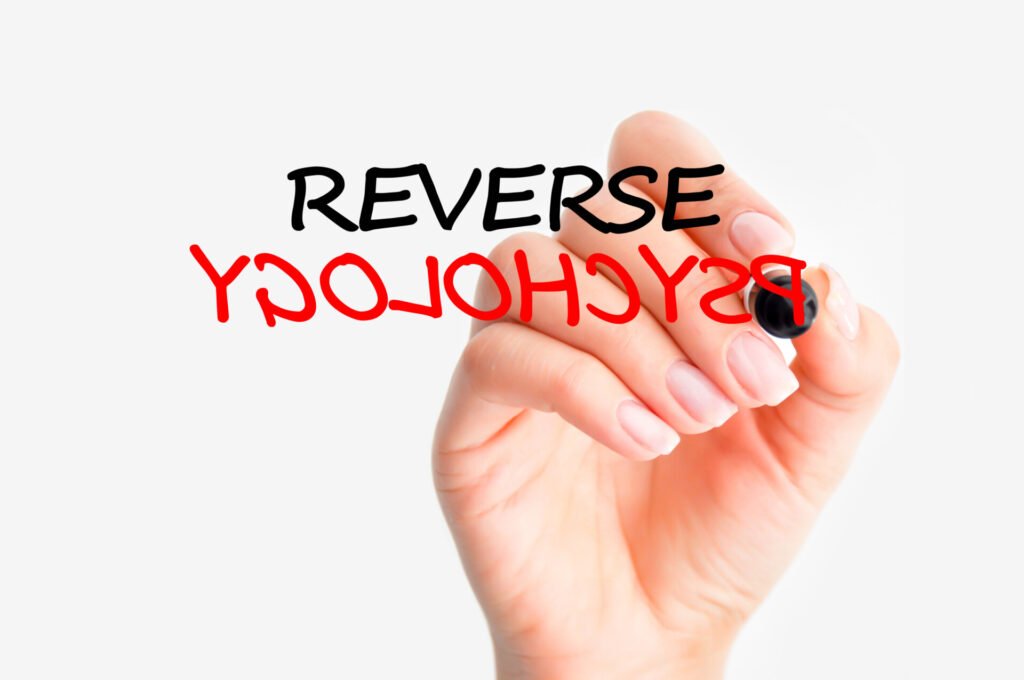
From the moment you wake up until the time you close your eyes at night, you’re bombarded with decisions. Often, the choices you make are influence by many psychological factors, even though you might not always be aware of them. One such intriguing psychological maneuver is reverse psychology. This fascinating technique, when employed , can shape behaviors and decisions. But have you ever wondered about its potential in the realm of relationships, more specifically, in enhancing commitment?
Unraveling Reverse Psychology
Reverse psychology might sound like a weird idea if you’ve never heard of it. But we actually use it a lot in our daily lives. It’s when you say the opposite of what you really want, hoping that the other person will do what you want them to.
Think of it like a small push towards the thing you want, but in a sneaky way. This can be very useful in relationships, where people are looking for a strong bond, understanding, and most of all, commitment.
The Relevance of Reverse Psychology in Relationships
In the maze of relationships between people, commitment is the sticky stuff that keeps everything together. But often, we need to work on and support this commitment. That’s where reverse psychology can help. By using this trick, you can motivate your partner to put more into the relationship, which makes the bond stronger.
But let’s be clear, this doesn’t mean you’re manipulating them. When you use reverse psychology the right way, you’re helping your partner change their behavior in a good way. You’re encouraging them to understand and accept their feelings and commitment to the relationship. It can be as simple as giving your partner some room to realize how important you are to them or getting them more involved in deciding your relationship’s future. And you can use this trick to help your partner commit.
The Art of Employing Reverse Psychology
As you journey through the vast and complex terrain of relationships, how do you use reverse psychology to get him to commit? Let’s preview a few key strategies:
Encourage Independence: Everyone cherishes their independence. By encouraging your partner to enjoy their independence, you’re subtly allowing them to realize your value in their life. This can amplify their commitment towards you and the relationship.
Involvement in Decision-Making: Make your partner feel like they’re in control by involving them in important decisions. This will not only make them feel valued but will also increase their investment in the relationship.
Patient Listening: When conflicts arise, instead of pushing your perspective, try to listen patiently. This may encourage your partner to reconsider their stance and be more open to resolution.
Don’t forget, the aim of these tips is to improve understanding, respect, and commitment in your relationship. It’s all about making a stronger partnership where both people put in the same effort.
As we go through this blog, we’ll take a closer look at each tip, explaining how to use reverse psychology to encourage commitment. It’s time to use the unexplored power of reverse psychology to help build a stronger, longer-lasting commitment.
Keep following along as we uncover the secrets of reverse psychology, changing the way you see commitment in relationships. Let’s go on a journey that will change how your relationship works and create a commitment that really lasts.
Understanding Reverse Psychology
Definition and Explanation:
Imagine this: you’re trying to get someone to do something. But instead of asking them directly, you tell them to do the total opposite. It seems odd, right? Yet, this method, called reverse psychology, often works really well. It’s based on the fact that we all want to be free and don’t like being told what to do.
So, what’s reverse psychology? It’s a way to convince people by suggesting the exact opposite of what you want, hoping that they’ll do what you actually want. The idea is that people don’t like being bossed around. So, when they feel like they’re being controlled, they often do the exact opposite to show their freedom, which makes them do what you wanted in the first place.
Psychological Mechanisms at Play:
To really understand how powerful reverse psychology is, let’s talk about the mind-related ideas behind it. One of the most important is called the cognitive dissonance theory.
Cognitive dissonance means the uncomfortable feeling people get when they have two or more different ideas or beliefs at the same time. This theory says that we naturally want to get rid of this discomfort and make our ideas match up. When you use reverse psychology, it makes this discomfort, and that makes us change our beliefs or actions to feel better.
Here’s an example: if someone can’t decide about making a commitment and you use reverse psychology by telling them they’re not ready for it, it could cause this discomfort. They might struggle with not being able to decide and wanting to show they can commit, and end up making the commitment to feel better.
Another interesting thing about reverse psychology is how it makes a mind-related reaction to go against resistance. This is based on the idea of psychological reactance, which says that when people feel their freedom is being threatened, they feel an uncomfortable emotional reaction called reactance. This reaction often makes them want to get their freedom back by doing the opposite of what’s being suggested, which is why reverse psychology works.
In simple terms, reverse psychology works by using our natural desire for freedom and our dislike of being controlled. It seems to threaten our freedom, which makes us want to go against it and, in doing so, makes us do the action or make the decision that was wanted from the start.
By understanding reverse psychology and the mind-related theories behind it, we can use a powerful tool for communication and influence. Whether it’s making stronger commitments in relationships or motivating ourselves or others to change their behavior in a good way, there are many ways to use this tool. But it’s important to use this tool in a good way, making sure it helps people rather than tricks them.
Establishing the Foundation for Commitment
Navigating the intricate labyrinth of human relationships is as much about understanding oneself as it is about understanding the other. Establishing a strong commitment in a relationship is no different. It requires laying a robust foundation, and this foundation is built on two crucial elements: self-reflection and connection.
Self-Reflection and Clarity:
Before embarking on the journey to cultivate commitment, it’s essential to delve inward first. Self-reflection is a powerful tool that allows us to gain clarity about what we truly want from a relationship and whether commitment aligns with these desires. It’s about understanding if we’re genuinely ready to devote ourselves to the other person or if we’re merely succumbing to societal pressure or perceived expectations.
Self-reflection should include an honest assessment of one’s readiness for commitment. It requires individuals to introspect their motivations: Are they considering commitment due to a deep-seated love for their partner? Is it because they can envision a future together? Or is it merely a decision made in haste, spurred by fear of loneliness or societal expectations? These questions might be tough, but the answers hold the key to authentic and lasting commitment.
Building a Strong Connection:
Once you’ve established the clarity of your intent through self-reflection, the next step is to build a strong connection with your partner. A robust commitment cannot exist in isolation; it needs the fertile soil of emotional intimacy and trust.
Fostering emotional intimacy involves sharing your deepest thoughts, fears, and dreams with your partner. It’s about being vulnerable and open, which in turn helps cultivate an environment of mutual trust. Emotional intimacy is the glue that bonds individuals together, making it easier to navigate the stormy seas that relationships often encounter.
However, fostering emotional intimacy is impossible without effective communication. The ability to express your thoughts and feelings clearly and empathetically is crucial. Effective communication goes beyond mere verbal exchanges—it’s about understanding body language, respecting silences, and recognizing the unsaid. It’s about making your partner feel heard, understood, and valued.
Moreover, effective communication also involves the resolution of conflicts in a healthy manner. Disagreements are inevitable in any relationship. However, the way you manage these disagreements can significantly impact the strength of your bond and the resilience of your commitment.
Applying Reverse Psychology
Having established a solid understanding of reverse psychology and its implications for relationships, let’s explore how we can apply it effectively to foster commitment. Two powerful techniques involve highlighting independence and presenting options.
Highlighting Independence:
When it comes to relationships, one might assume that emphasizing togetherness is the key to enhancing commitment. However, paradoxically, underlining independence can have a potent impact.
By advocating personal growth and individual goals, we pique our partner’s interest and create an aura of autonomy. This is not about driving a wedge but rather fostering a sense of individual identity within the relationship. When a person perceives their partner as someone with distinct interests, aspirations, and a strong sense of self, it enhances their attractiveness and can prompt a deeper commitment.
Moreover, showcasing one’s happiness and fulfillment outside the relationship can prove to be a powerful tool. It is only natural for people to be drawn towards those who are content and confident within themselves. When your partner sees you pursuing your passions, thriving in your career, or enjoying your social life, it not only makes you more appealing but also subtly suggests that your happiness does not solely depend on the relationship. This can prompt your partner to invest more in the relationship, leading to a stronger commitment.
Presenting Options:
Another strategic application of reverse psychology lies in the art of offering choices. By doing so, you can foster a sense of autonomy, a trait that people inherently value.
For instance, instead of demanding commitment from your partner, you could present it as a choice. This approach might look something like, “I want us to consider taking our relationship to the next level, but I understand if you’re not ready yet. It’s a big step, and I want you to feel comfortable with it.”
This statement presents commitment as a voluntary decision rather than an obligation. It emphasizes that the person is free to choose, thereby enhancing the desirability of commitment. Paradoxically, by suggesting that they might not be ready for it, you could provoke them to assert their readiness, moving them closer to the desired outcome.
In summary, applying reverse psychology to enhance commitment involves an adept balance of promoting independence and presenting options. By fostering a sense of autonomy and showcasing your fulfillment outside the relationship, you subtly encourage your partner towards deeper commitment. Remember, however, that the ultimate goal should always be a healthy, mutually beneficial relationship where both parties feel valued and respected.
Ethical Considerations and Limitations
As we delve into the intriguing world of reverse psychology and its potential to enhance commitment in relationships, it’s essential to tread with care. While this psychological tool can be incredibly potent, it’s crucial to employ it with transparency, trust, and a deep understanding of individual differences.
Transparency and Trust:
Open and honest communication is the cornerstone of any healthy relationship. Therefore, while using reverse psychology, it’s important to ensure that your actions do not compromise the trust your partner places in you.
While reverse psychology can be used to encourage desired behaviors, it should never serve as a tool for manipulation. Using this technique to deceive or control your partner can erode the foundation of trust and mutual respect, leading to detrimental consequences for the relationship. Therefore, while employing reverse psychology, one must always ensure their intentions are genuine and respectful.
Individual Differences:
Another vital consideration when employing reverse psychology is the unique dynamics of your relationship and your partner’s personality. Not everyone responds to reverse psychology in the same way. While some people might react positively, others might perceive it as a form of control and respond negatively.
It’s crucial to understand your partner’s communication style, preferences, and personality traits before using reverse psychology. This approach requires keen observation, empathy, and adaptability. The goal should always be to enhance mutual understanding and foster a healthier, more resilient commitment.
Conclusion
The idea of reverse psychology, even though it might sound strange, can be a strong way to guide behavior and build commitment. But, this tool should always be used honestly and in a good way. It should help improve how we talk to each other, understanding each other, and respecting each other, instead of using it to control or trick someone.
In the end, creating a lasting commitment is not about clever mind tricks, but about being true, feeling connected emotionally, and communicating clearly and kindly. It’s about knowing what your partner needs and adjusting to the special ways of your relationship.
As you go through your relationship, remember that the main goal should be to create a partnership that lets both you and your partner grow on your own and together. So, use reverse psychology carefully, balance freedom with connection, offer choices without pressure, and always be honest and open. Here’s to building stronger, lasting commitments!


